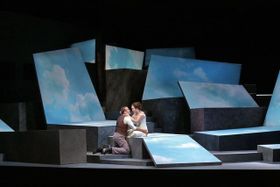|
Back
Laurent Pelly's La Traviata returns Santa Fe
Santa Fe Opera
07/20/2013 - & July 24, 29, August 2, 5, 10*, 16, 22, 2013
Giuseppe Verdi: La traviata
Brenda Rae (Violetta Valery), Jennifer Panara (Flora), André Courville (Marquis d'Obigny), Keith Jameson (Gastone), Michael Fabiano (Alfredo), Jonathan Michie (Baron Douphol), Dale Travis (Doctor Grenvil), rebecca Witty (Annina), Roland Wood (Germont)
The Santa Fe Opera Chorus, Susanne Sheston (chorus master), The Santa Fe Opera Orchestra, Leo Hussain (conductor)
Laurent Pelly (director and costume designer), Chantal Thomas (set designer), Camille Dugas (associate set designer), Duane Schuler (lighting designer)

M. Fabiano & B. Rae (© Ken Howard)
The more conventional side of Santa Fe's season continues with Verdi's most famous opera, a poignant tale of love, sacrifice, and loss. The revival of Laurent Pelly's production raised high expectations, not in the least because of the casting of the young tenor Michael Fabiano as Alfredo. Still on the right side of 30, Fabiano has had a strong buzz around him for some time now. The 2007 documentary film The Audition features him in its study of the Metropolitan Opera's National Council auditions. Early this year he received national media attention for a performance with the Opera Orchestra of New York. And impressive he was. Blessed with a bright, clarion voice, Fabiano commanded the role and all of his scenes with all the verve and flair of an audacious Verdi tenor.
His leading lady Brenda Rae also made a fine impression, though the Act I coloratura roulades lacked the necessary power and breadth of tone. The different voices required for Acts II and III were deployed to better effect. The soubrette passages of "Addio, del passato" showcased her talent at its best.
Roland Wood's gravelly Germont grated as the evening went on. Conductor Leo Hussain directed a slowly paced performance interrupted by odd pauses and glacial tempos that at times eviscerated the drama.
Pelly's production is less inspired than many of his other efforts, especially in comic opera. All three acts take place on and around cubical blocks that dominate the stage. Violetta's party guests must scramble over them to indulge in decadent fun. Perhaps the most original element in the scene is the extent of their debauchery. Rather than just stand around and drink champagne as they usually do, here they flirt and fornicate in all sorts of delicious combinations. The first scene of Act II, Violetta and Alfredo's love nest, gives the blocks elements of blue skies and clouds, but the point is uncertain. Flora's party, the site of their confrontation, looks like some kind of bizarre disco before the institution existed. And in Act III, when Violetta is dying, the blocks are not too originally covered with sanitary white sheets. One of them is awkwardly dressed as her bed. Pelly added a few questionable touches. The opera's introductory music tells the story in reverse, but did we really need a funeral procession carrying a coffin (presumably Violetta's but who knows?) across the stage? Then at the finale, Violetta dies alone after Alfredo and his repentant father exit the stage. Surely people with their undisguised emotional investment in the drama should stay.
Paul du Quenoy
|